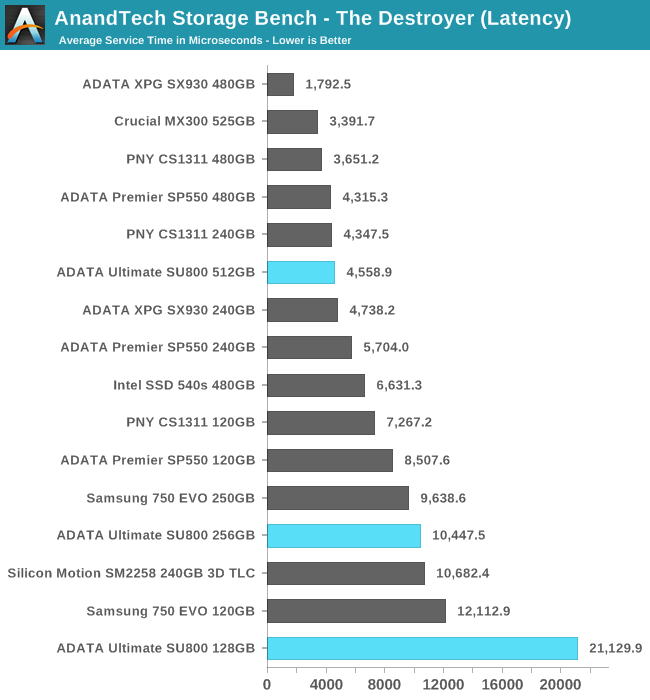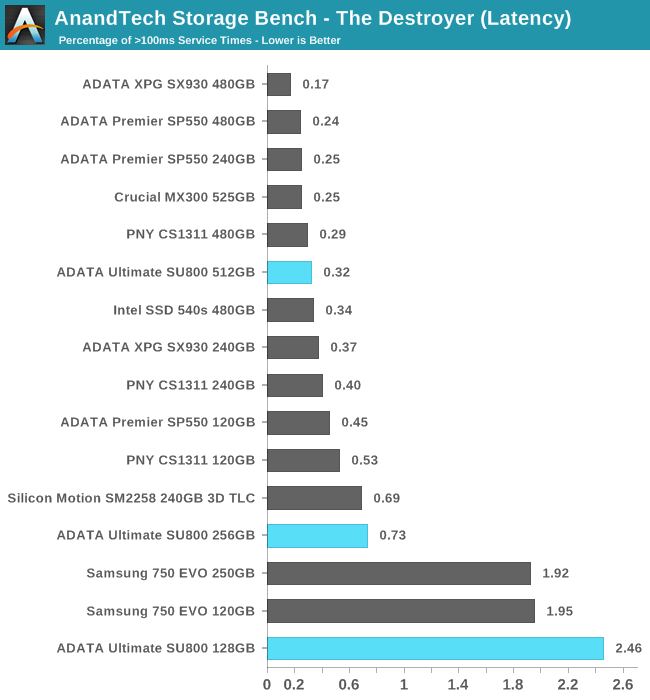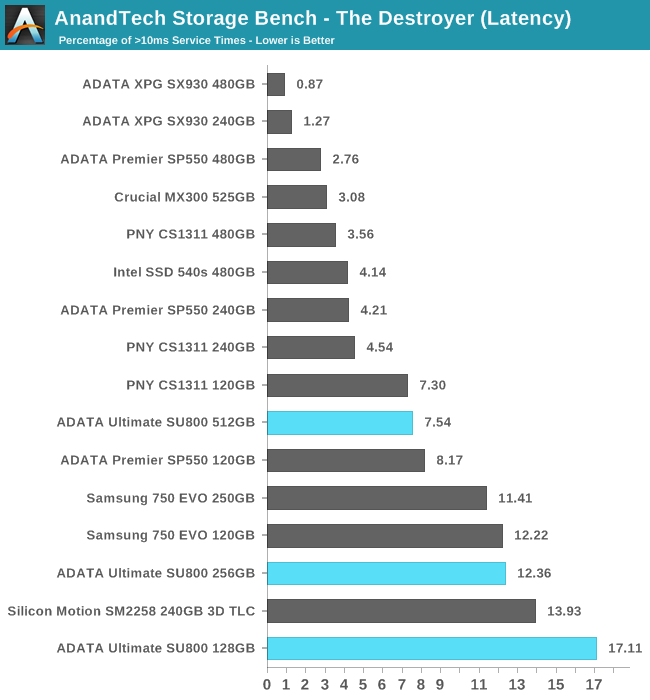The ADATA Ultimate SU800 SSD Review (128GB, 256GB, 512GB)
by Billy Tallis on February 1, 2017 12:01 PM ESTAnandTech Storage Bench - The Destroyer
The Destroyer is an extremely long test replicating the access patterns of very IO-intensive desktop usage. A detailed breakdown can be found in this article. Like real-world usage and unlike our Iometer tests, the drives do get the occasional break that allows for some background garbage collection and flushing caches, but those idle times are limited to 25ms so that it doesn't take all week to run the test.
We quantify performance on this test by reporting the drive's average data throughput, a few data points about its latency, and the total energy used by the drive over the course of the test.

The average data rates delivered by the ADATA SU800 are slower than most of its competition, but it is improved over the earlier engineering sample from Silicon Motion and the Intel 540s that paired the SM2258 controller with SK Hynix 16nm TLC.

Latency is a weak point for the SU800, with average service times that are higher than almost all of its competition. The 128GB SU800 suffers the most, with an average over 21ms.


Aside from the smallest 128GB capacity, the SU800 doesn't have too many operations that take more than 100ms to complete, but at the 10ms threshold all three capacities rank poorly against the competition.

With so much time spent bogged down by garbage collection, it is no surprise that the smaller capacities of the SU800 use somewhat more power than most of the competition. The 512GB SU800 compares favorably against the planar TLC competition, but doesn't come close to the efficiency of the Crucial MX300.










35 Comments
View All Comments
SaolDan - Wednesday, February 1, 2017 - link
Neat!!!MrSpadge - Wednesday, February 1, 2017 - link
Overall a worse deal than the MX300, which itself took quite some criticism. Could you elaborate on what's "neat" about this?vladx - Wednesday, February 1, 2017 - link
Price is low for decent performance. This is SATA SSD targeted towards low end and mainstream market.Great_Scott - Wednesday, February 1, 2017 - link
The MX300 is better value given the drive sizes. I'm still trying to find a replacement for the Mushkin Reactor for desktops, but the Crucial drive is my go-to for laptops currently.Arbie - Wednesday, February 1, 2017 - link
Why do you guys continually fail to mention the Mushkin Reactor 1TB MLC drive ($240 at Newegg) in your SSD comparisons? It's cheaper, faster, and probably has greater endurance.You reviewed it two years ago but have hardly mentioned it since then. It seems to be a "best buy" still.
http://www.anandtech.com/show/8949/mushkin-reactor...
But... kudos on the clickbait. You have at least as much as any other site, and of the lowest degree.
vladx - Wednesday, February 1, 2017 - link
Because Mushkin already refreshed their SSD line and the old Reactor is not manufactured anymore which means it will be gone any week now.Great_Scott - Wednesday, February 1, 2017 - link
And we will all be sad to see it go. I have a bunch of those drives, myself.Flunk - Wednesday, February 1, 2017 - link
They don't often put 2 year old drives in comparisons.Great_Scott - Wednesday, February 1, 2017 - link
That's too bad, as some context would be useful, especially considering that many people own that drive, and until recently it was still being made.Then again, a two-year-old budget drive with a very similar controller would have made the SU800 series look terrible, and we can't have that.
eek2121 - Wednesday, February 1, 2017 - link
The Mushkin Reactor is a drastically slower drive, costs about the same, and will soon disappear from retailers. It is not a competitor.